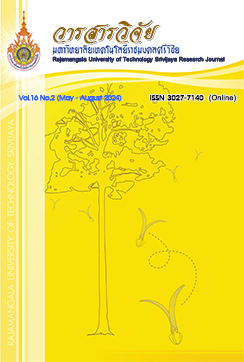Numerical Study of Hydrogen Combustion on Micro Combustor with Exhaust Gas Recirculation Jacket for Enhancement of Emissive Power
Keywords:
micro combustor, cylindrical EGR, hexagonal EGR, wall temperature, emissive powerAbstract
This research is to study the numerical model of hydrogen combustion in a micro combustor to enhance the energy converted to electricity by analyzing wall temperature and emissive power. This research focuses on the affected parameters of micro combustor geometry (rectangle, cylinder, hexagon), exhaust gas recirculation (EGR) at a hydrogen mass flow rate of 1.8551x10-5 kg/s, and an equivalence ratio of 1.0. As the result, wall temperatures ranging from 18.8 to 19.7 oC and emissive power between 12.2 and 12.4% were observed from cylindrical and hexagonal micro combustor, which were higher than those of rectangular micro combustor. Moreover, the installation of hexagonal EGR and cylindrical EGR with micro combustor could enhance emissive power by 1.6 and 2.0 watt, respectively. This study indicates that the design of a cylindrical micro combustor with cylindrical EGR, covered with porous media, could achieve the highest emissive power of 12.26 watts, which is 33.7% higher than that of the referenced model.
References
Aravind, B., Raghuram, G.K.S, Kishore, V.R. and Kumar, S. 2018. Compact design of planar stepped micro combustor for portable thermoelectric power generation. Energy Conversion and Management 156: 224-234.
Jejurkar, S. and Misha, D.P. 2009. A review of recent patents on micro-combustion and applications. Recent Patents on Engineering 3(3): 194-209.
Hua, J.S., Wu, M. and Kurichi, K.M. 2005. Numerical simulation of the combustion of hydrogen–air mixture in micro-scaled chambers Part II: CFD analysis for a micro-combustor. Chemical Engineering Science 60(13): 3507-3515.
Lei, Y., Wei, C. and Lei, J. 2016. Combustion and direct energy conversion inside a micro combustor. Applied Thermal Engineering 100: 348-355.
Pan, J.F., Wu, D., Liu, Y.X., Zhang, H.F., Tang, A.K. and Xue, H. 2015. Hydrogen/oxygen premixed combustion characteristics in micro porous media combustor. Applied Energy 160: 802-807.
Di Sarli, V., Trofa, M. and Di Benedetto, A. 2020. A Novel Catalytic Micro-Combustor Inspired by the Nasal Geometry of Reindeer: CFD Modeling and Simulation. Catalyst 10(6): 606.
Su, Y., Song, J., Chai, J., Cheng, Q., Luo, Z., Lou, C. and Fu, P. 2015. Numerical investigation of a novel micro combustor with double cavity for micro thermophotovoltaic system. Energy Conversion and Management 106: 173-180.
Su, Y., Cheng, Q., Song, J. and Si, M. 2016. Numerical study on a multiple-channel micro combustor for a micro-thermophotovoltaic system. Energy Conversion and Management 120: 197-205.
Wan, J. and Fan, A. 2015. Effect of solid material on the blow-off limit of CH4/air flames in a micro combustor with a plate flame holder and preheating channel. Energy Conversion and Management 101: 552-560.
Wan, J., Fan, A., Yao, H. and Wei, L. 2015. Effect of thermal conductivity of solid wall on combustion efficiency of a micro – combustor with cavities. Energy Conversion and Management 96: 605-612.
Yang, W.M., Chou, S.K., Chua, K.J., Li, J. and Zhao, X. 2011. Research on modular micro combustor – radiator with and without porous media. Chemical Engineering Journal 168(2): 799-802.
Zuo, W., Jiaqiang E., Han, D. and Jin, Y. 2017. Numerical investigations on thermal performance of double-layer four-channel micro combustors for micro-thermophotovoltaic system. Energy Conversion and Management 150: 343-355.
Downloads
Published
How to Cite
Issue
Section
License
Copyright (c) 2024 Rajamangala University of Technology Srivijaya Research Journal

This work is licensed under a Creative Commons Attribution-NonCommercial-NoDerivatives 4.0 International License.
The content and information in the article published in Journal of Rajamangala University of Technology Srivijaya It is the opinion and responsibility of the author of the article. The editorial journals do not need to agree. Or share any responsibility.







